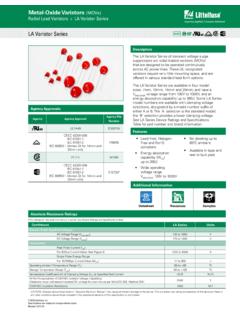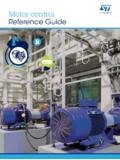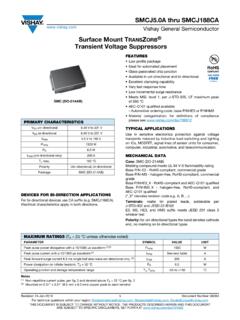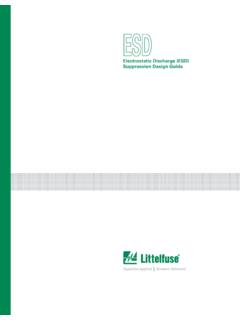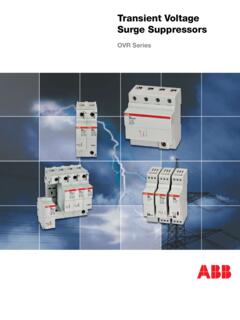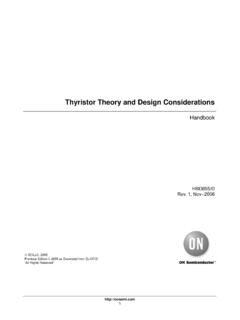Transcription of 技術資料(第3版) - mmc.co.jp
1 MITSUBISHI MATERIALS 2017 MITSUBISHI MATERIALS CORPORATIONT echnical data 9 MITSUBISHI MATERIALS CORPORATIONELECTRONIC MATERIALS COMPONENTS COMPANYELECTRONIC COMPONENTS DIVISION 3 Technical data surge Absorber MITSUBISHI MATERIALS 2017 MITSUBISHI MATERIALS CORPORATIONT echnical data 9 3 Technical data Contents 1 3 What is surge ?2 3 Induced Surge3 4 Invasion of Induced Surge4 4 What is a surge Absorber?5 4 SPD: surge Protective Device6 5 Micro-gap surge Absorber7 5 About Follow-On Current8 V-I 5V-I properties of gas discharge tubes9 6 What is Holdover?10 6 Mechanism of Holdover11 AC 7 Follow-on current from AC sources12 8 CONSULTING surge Test Service MITSUBISHI MATERIALS 2017 MITSUBISHI MATERIALS CORPORATIONT echnical data 9 surge Types Solving surge ProblemsSurge is abnormal transient voltage and is categorized according to where it is Mitsubishi Materials, we provide countermeasure devices/solutions for circuitry and ESD surge caused by electrostatic discharge as well as induced surge caused by lightning discharge.
2 2 b Fig. 2(b) Electromagnetic induction surge 2 a b When electric discharge (lightning) occurs between a lightning cloud and the ground, a severe electric current drifts and the electromagnetic induction surge produces an electromagnetic a power transmission line and the cable of a communication line exist near a lighting strike, they act as an antenna and electromagnetic induction causes abnormal an electric discharge occurs between lightning clouds or between a lightning cloud and the ground, abnormal voltage occurs by electrostatic induction and electromagnetic induction to the neighboring power transmission line or communication line.
3 This is what is called Induced surge as illustrated in (a) and (b). 2 a Fig. 2(a) Electrostatic induction surge When lightning occurs in the summer, a negative charge develops in the upper part of the lightning a power transmission line and a communication line cable exist under this lightning cloud, equilateral electric charges collect on the cable and high voltage induction surge occurs when a positive charge on a cable develops near a negative charge from a lightning cloud. When the cloud releases its charge to another cloud or the ground, the charge on the cable is released and travels in a wave, advancing in either direction. What is surge ?
4 Induced surge MITSUBISHI MATERIALS 2017 MITSUBISHI MATERIALS CORPORATIONT echnical data 9 Induced surge enters electronic equipment through power supply lines or communication lines. 4 Example of surge Protection 5 surge Protective Components (SPC: surge Protective Components) A device protecting electronic equipment from surge (abnormal voltage ) is called a surge Protective Components (SPC). SPC protect from entry of surge between the line to line interval or the interval from the line to the typically has a high resistance level and most of the electric currents do not flow (nor influence the electronic equipment).
5 However; when surge (abnormal voltage ) enters, the surge Absorber instantly eliminates surge with low resistance to protect the electronic equipment. When surge is eliminated, the SurgeAbsorber returns to high : Gas Discharge TubeMOV : Metal Oxide VaristorADB : Avalanche Breakdown DiodeTSS : Thyristor surge Suppressors 3 Invasion of Induced surge Invasion of Induced surge What is a surge Absorber? SPC: surge Protective Components surge Protective Components(SPC) Gas Discharge Tube(GDT) Micro-gap system Gap system Zinc oxide varistor Avalanche Breakdown Diode(ABD) Thyristor surge Suppressors(TSS) Metal Oxide Varistor(MOV) Semiconductor MITSUBISHI MATERIALS 2017 MITSUBISHI MATERIALS CORPORATIONT echnical data 9 6 Micro-gap surge Absorber (Lead wire type) 7 Micro-gap surge Absorber (SMD type) 8 surge response waveforms by different surge protections 9 V-I V-I properties of gas discharge tubes 1 2 10M 3 1pF 4 5 6 <Benefits>1) Excellent surge response2) High insulation resistance (more than 10M )3)
6 Low capacitance (less than 1pF)4) No dark effect5) Two-directional6) Lead wire type and SMD type available1.. JIC C 5381-311 150msec. V What is Follow-on current?
7 Follow-on current is electricity that will continue to flow; in this case it is a phenomenon where the current in a discharge tube continues to , surge Absorbers are in high impedance. When a surge enters the surge Absorber, it will drop to low impedance, allowing the surge to bypass the electronic circuit it is protecting. After the surge has passed, the surge Absorber should return to high , when the surge Absorber is in low impedance and there is sufficient voltage on the line to keep current flowing, the surge ends and the surge Absorber remains in discharge. The surge Absorber fails to return to high impedance and the current continues to flow. This is a phenomenon known as follow-on Absorbers that display this follow-on current are discharge-type and semiconductor switching-type. A characteristic of these absorbers is that during surge absorption (bypass), the operating voltage (remaining voltage ) is lower than the starting advantage of these surge Absorbers is that during suppression, the voltage is held very low, so it reduces stress on the equipment.
8 However, a problem arises when the line current of the equipment is high enough that it continues to drive the surge Absorber even when the voltage is current mechanisms are explained further in the next chapter, along with the discharge tubes. 9 V-I The micro-gap type surge Absorber is a type of discharge tubes. The discharge in the tube changes from pre-discharge to glow discharge, then to arc discharge as illustrated in illustration below also shows the V-I characteristics between voltage and current for the discharge the tube is discharging, electric current flows and moves to glow discharge then to arc discharge as the discharge voltage decreases.
9 On the other hand, when the discharge decreases, the voltage increases as it moves from arc discharge to glow discharge. Pre-glow discharge The voltage to maintain the discharge is equivalent to the DC breakdown voltage . A faint light can be seen from at this point. Glow discharge The constant voltage rate remains as the current changes. The voltage to maintain the discharge depends on the electrode material and the gas in the tube. The discharge light covers portion of the electrodes. Arc discharge At the end of discharge and a large current flows through the part and it puts out a bright light. The maintaining voltage at this point ( voltage between the discharge tube terminals) is in the 10's of volts range. About Follow-On Current V-I properties of gas discharge tubes Micro-gap surge Absorber V-I Vari stor Typical gas tube Impulse waveform Micro-gap surge absorber Time DC spark-over voltage Equipment surge limit voltage MITSUBISHI MATERIALS 2017 MITSUBISHI MATERIALS CORPORATIONT echnical data 9 DC CRT When a discharge tube is used on a circuit that has a DC voltage component, there is a phenomenon occurs, called holdover, where the discharge in the tube continues being driven by the current from the power supply even after the surge voltage has a holdover occurs.
10 For example when it is occurs in the drive circuit of a CRT, the screen darkens and discharge in the absorber continues, which can lead to the glass tube melting, smoking or burning. 10 No Holdover occurring 11 Holdover occurringRVo InsidecircuitIv Vo R I v 12 v=Vo-I R 1 Vo V-I V-I V-I 12 V-I V-I V-I 12 V-I Holdover can occur









